Authentic German Springerle Cookies
This post may contain affiliate links. See my disclosure policy.
Springerle are German anise-flavored cookies that go back at least 700 years in their rich tradition as special gifts during the holidays and other celebrations. Delicately crispy-crunchy and a slightly chewy center, they’re made with simple ingredients and are easy to make but absolutely require that you follow some key steps to achieving the right look, texture and flavor. This authentic Springerle cookies recipe goes back to the Swabia region of Germany where these famous cookies originated.
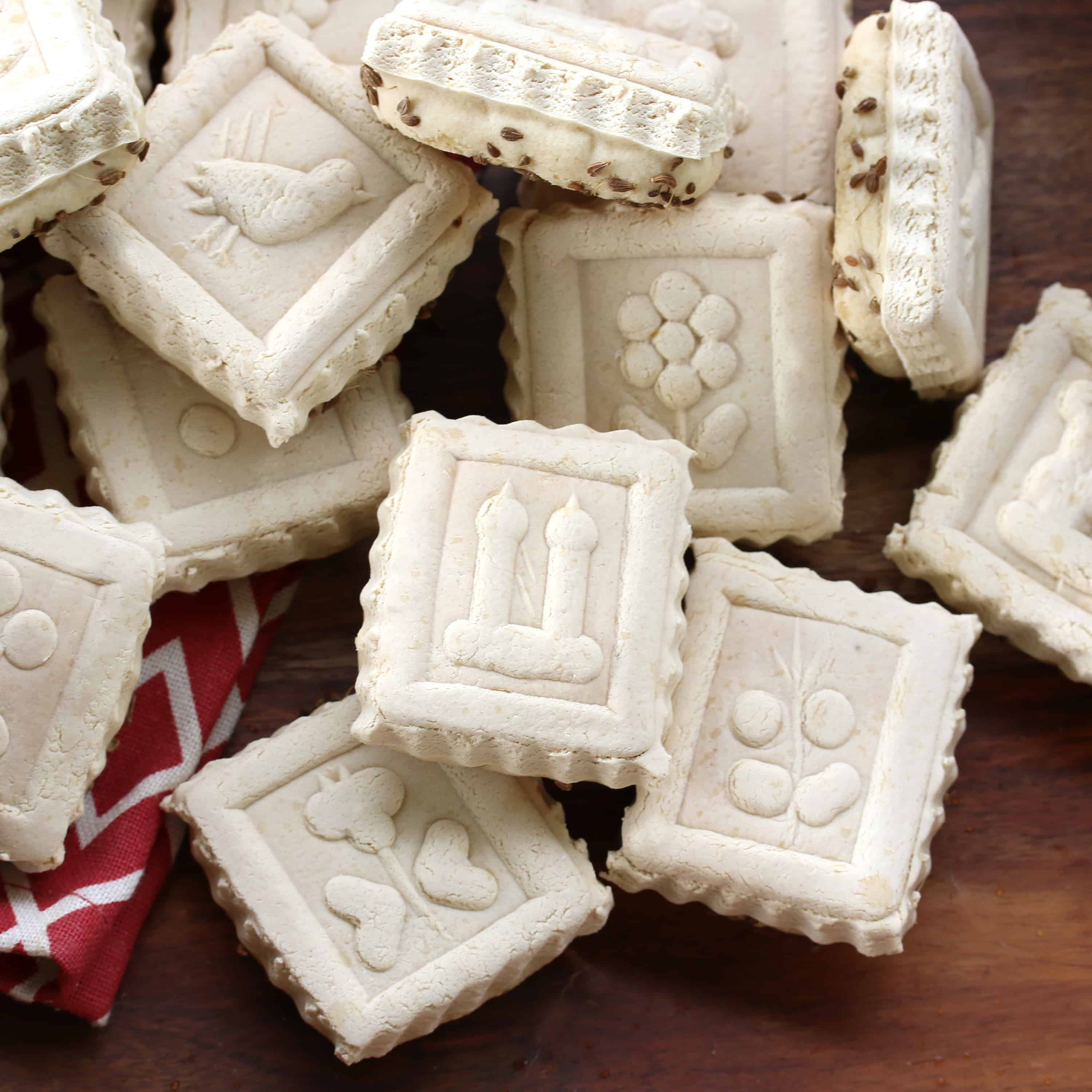
What Are Springlere Cookies?
Springerle are traditional German cookies with a very long, very rich history and tradition and come from the Swabia region of southern Germany where I’m from. They’re delicately flavored with anise and are embossed with a variety of designs. Historically made for religious holidays and other special occasions, today they are most commonly made during the Christmas season and for New Year’s though Springerle with flowers, landscapes and other everyday designs remain popular throughout the year. The name “Springerle” translates from German as “little jumpers” because of their behavior of rising or “jumping up” while they’re baking.
Authentic Springerle are made with eggs, sugar, flour, baker’s ammonia, salt and anise. They’re a very low-moisture cookie that are made without any fat. Springerle are very hard cookies that are stored long-term to undergo a period of “ripening” for several weeks as their flavor and texture develops. Over time they develop a delicately crispy-crunchy, shattering exterior and a slightly chewy center. They are traditionally eaten with and dunked in a hot beverage.
The hallmark of Springerle lies in the beauty of their presentation created by special molds used to emboss designs on their surface. Springerle were traditionally made as gifts, as charms for happiness, to give to friends and loved ones on special occasions such as births, weddings, betrothals, during the Christmas season and on New Year’s.
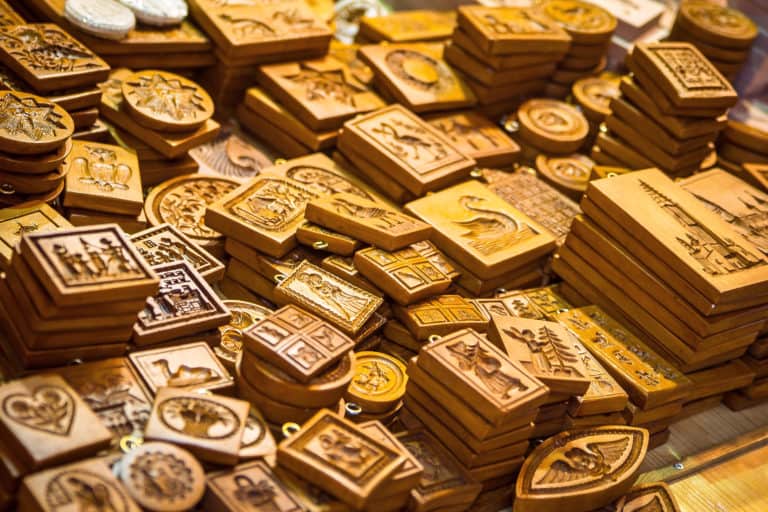
A Brief History of Springerle Cookies
These renowned cookies can be traced back to at least the 1300’s to the Swabia region of southern Germany where they were regarded as charms for good luck, happiness and religious observance. Historically Springerle molds were a German baker’s opportunity to show off his woodcarving skills. At that time baking apprentices in Swabia Germany not only had to demonstrate their ability to bake, they also had to carve their own Springerle molds as a kind of rite of passage to becoming a full-fledged, bona fide baker. The more intricate and detailed the mold, the more heralded the baker. These molds were passed down from generation to generation as treasured family heirlooms.
In fact, so prized were these family heirlooms that Germans immigrating to the United States in the 17th and 18th centuries would make space in their luggage just for their Springerle molds.
The themes of the Springerle molds changed throughout the centuries, transitioning from the earlier religious symbols in the 15th century to scenes of gallantry with knights on horseback, then on to the more romantic and highly detailed images of the 19th century with flowers, landscapes, and symbols of love, marriage and friendship. In the 20th century designs included things like Santa Claus, reindeer, and Christmas trees.
You can still buy both simple and elaborate wood-carved Springerle molds in Germany and you can also find antique ones that usually command a hefty price, especially the very detailed ones.
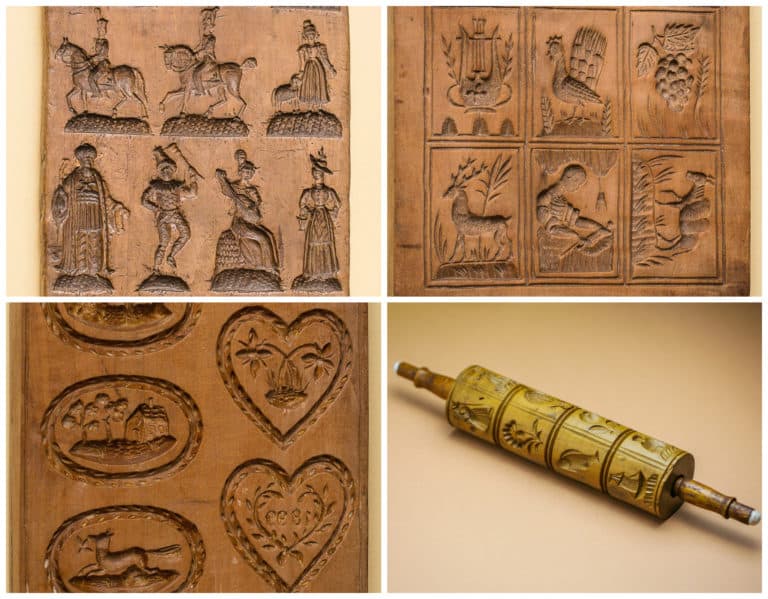
Special Equipment: Springerle Cookie Molds
Trying to find Springerle molds outside of Germany and other European countries that make cookies using molds (eg, Belgium and the Netherlands’ well-known speculoos/speculaas cookies), is very challenging. You can buy antique molds on eBay at a premium price or you can just use whatever you have that’s available. For example, you can use cookie stamps. There are a number of inexpensive ones on the market as well as high quality ones like these cookie stamps from Nordic Ware that are built to last and whose designs are cut deep enough to make a good impression on the cookie (Nordic Ware has multiple designs to choose from). I have three different sets of Nordic Ware cookie stamps.
Pictured below is my Springerle rolling pin that I brought with me from Stuttgart, Germany before I moved to the U.S.. This is the mold that I used in the pictures for this recipe. A Springerle rolling pin is easy to use and you can crank out a ton of Springerle very quickly. Amazon has a hand-carved Springerle rolling pin that looks similar to mine.
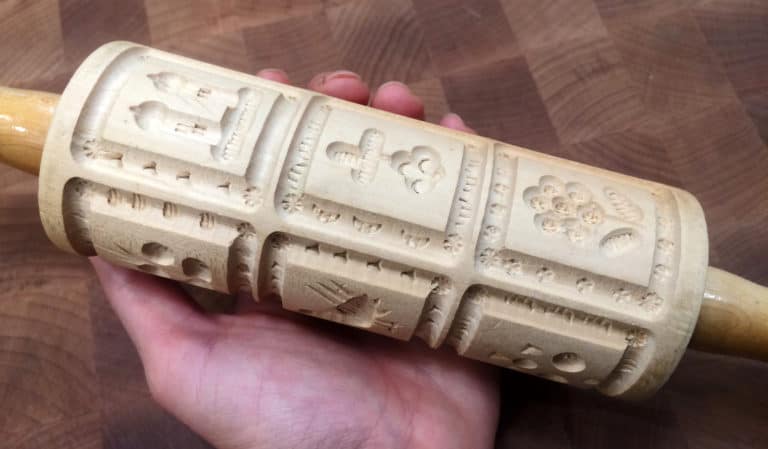
How to Make Authentic Springerle Cookies
I’m going to share 5 keys with you, 5 essential elements, for making authentic German Springerle.
Key #1 to Making Authentic Springerle: Baker’s Ammonia
Ammonium bicarbonate, known as baker’s ammonia, is an old-fashioned leavening agent that was commonly used until the 19th century when baking soda and baking powder came onto the scene. If you look through very old cookbooks you’ll find baker’s ammonia in the list of ingredients for specific kinds of baked goods. And while baking powder and baking soda largely replaced and perform a similar function to baker’s ammonia, they are not one and the same. In Europe and the Middle East, for example, some recipes for low-moisture things like crackers and crispy cookies still call for baker’s ammonia because of its unique qualities that baking powder or baking soda cannot replicate. It’s also used (either that or potash) for other types of “flat” baked goods such as German Lebkuchen, Honigkuchen and a German pastry known as Amerikaner, to “loosen” the texture of their crumb.
Springerle are the perfect example of a baked good that really requires the use of baker’s ammonia to get the right results and that’s traditionally what they were always made with.
It doesn’t matter which brand you use, but select one that’s food grade. I’ve been using organic food grade Baker’s Ammonia from Pure Organics.
*Just a note of warning: Baker’s ammonia smells BAD. Really bad. But don’t worry, the smell dissipates during baking.
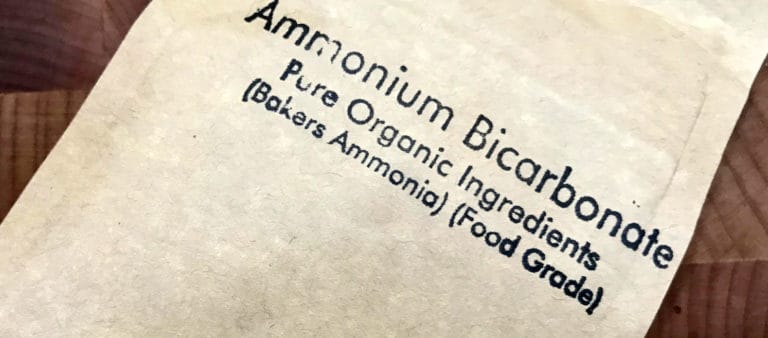
Baker’s Ammonia vs. Baking Powder vs. Baking Soda
Besides having different chemical compositions, they perform differently. While all three are leavening agents, baker’s ammonia creates an effect that baking powder and soda cannot replicate. As the cracker or cookie is baking, the tiny crystals in the ammonium bicarbonate break down and leave tiny air pockets behind in the crumb. The best way to describe the effect is that baker’s ammonia creates a unique honey-combed, porous crumb so that hard baked goods like crackers and cookies/biscuits have a more delicate, crispier, crunchier texture. Baker’s ammonia also contributes to a more even spread of the cookies.
Baker’s ammonia does have a very strong, very unpleasant odor but don’t be put off by that – the odor and taste will dissipate during baking.
In contrast what you normally get with a baked good that has virtually no moisture in it is something you could break your tooth on or could serve as a door stopper. (Think military hard tack from generations ago. Soldiers had to dip it in their coffee in order to make it edible.)
THAT is what you get if you make Springerle without baker’s ammonia: Rock hard, tooth-breaking, door-stopping cookies.
But let’s also be clear on something: Springerle are meant to be hard. And they’re traditionally eaten with a hot beverage for dipping. But the difference is that the baker’s ammonia creates that honey-combing effect that makes them less dense and gives them a more delicate and crunchy crumb.
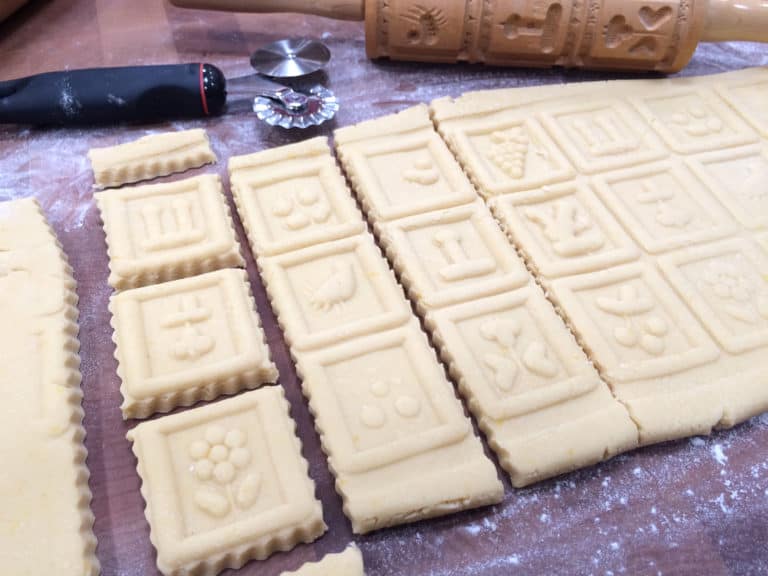
In addition to the texture advantage of using baker’s ammonia for low-moisture, crispy goods, it also doesn’t leave behind the characteristic soapy flavor that baking powder or soda does.
Cook’s Illustrated’s verdict: “[Baker’s ammonia] works so well, we’d be tempted to use it for crisp baked goods all the time if it were more readily available.” The good news is that it’s readily available online.
Key #2: Authentic Springerle DO NOT Use Butter or Fat of Any Kind. ZERO.
What about the fact that most of the recipes out there on the web don’t call for baker’s ammonia? How do they try to get around the hard-as-a-rock, tooth-breaking factor? They add butter. They add fat in their workaround to soften it up a bit. The result? Shortbread, not Springerle. Different flavor, different texture.
So use the butter to make Scottish Shortbread. But if you want Springerle leave the butter in the fridge. There is no place for butter in traditional Springerle.
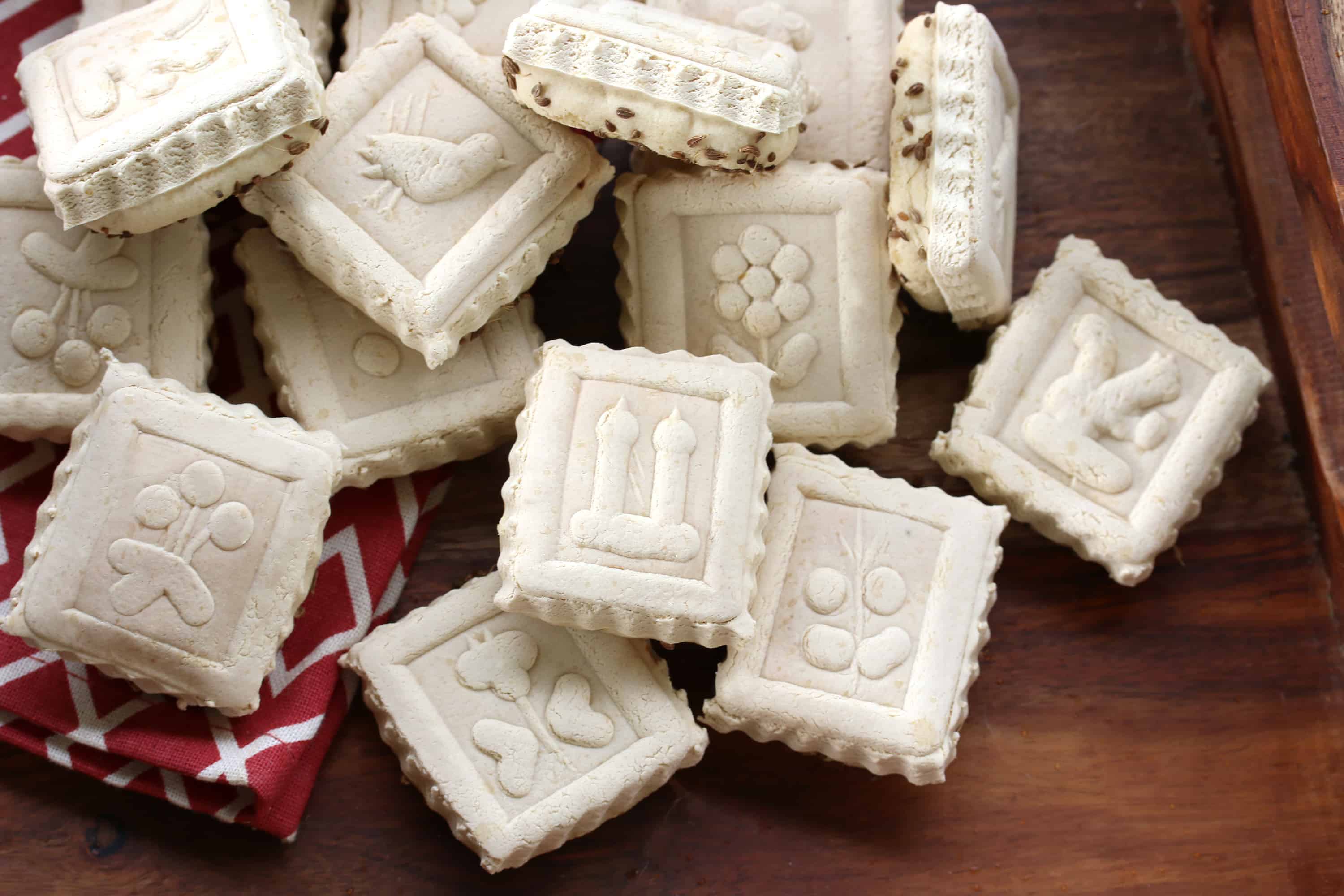
Next let’s talk about the flavor of traditional Springerle. Being made with nothing but eggs, flour and sugar they really have very little flavor. That’s where the anise comes in. There’s also the addition of the lemon zest which is optional but which we recommend because it contributes a lovely bright contrast and balance to the anise.
Key #3: Fresh Anise Seeds and Quality Pure Anise Oil
Traditionally whole anise seeds are always used. They’re dry roasted in a pan to release their oils and maximize flavor, then they’re strewn across the baking sheet before the Springerle are set on top of them. In addition to the anise seeds many German bakers will also add a few drops of pure anise oil for an added boost in flavor. We also recommend it.
The quality of your anise oil matters. It needs to taste real and it needs to be potent enough so that you only need to add a tiny bit of the oily liquid to achieve the flavor effect. So be sure to use quality 100% pure anise oil.
I use and recommend Lorann’s 100% Pure Anise Oil. It’s very potent and a few drops go a long way.
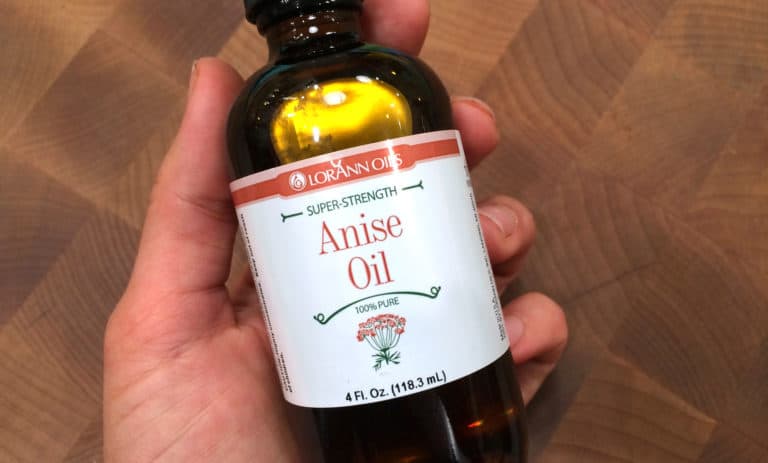
Key #4: Let the Springerle Air Dry For 24 Hours Before Baking Them
The whole purpose of Springerle are to be able to showcase their beautiful embossed designs and if you bake them right away the designs will not hold their shape or form.
In order for the embossed designs to stay in place during baking you need a dough that is super low-moisture to start and then the cookies need to be left to further dry out and develop a hardened crust on the exterior. This way the designs remain stable and unaltered during baking.
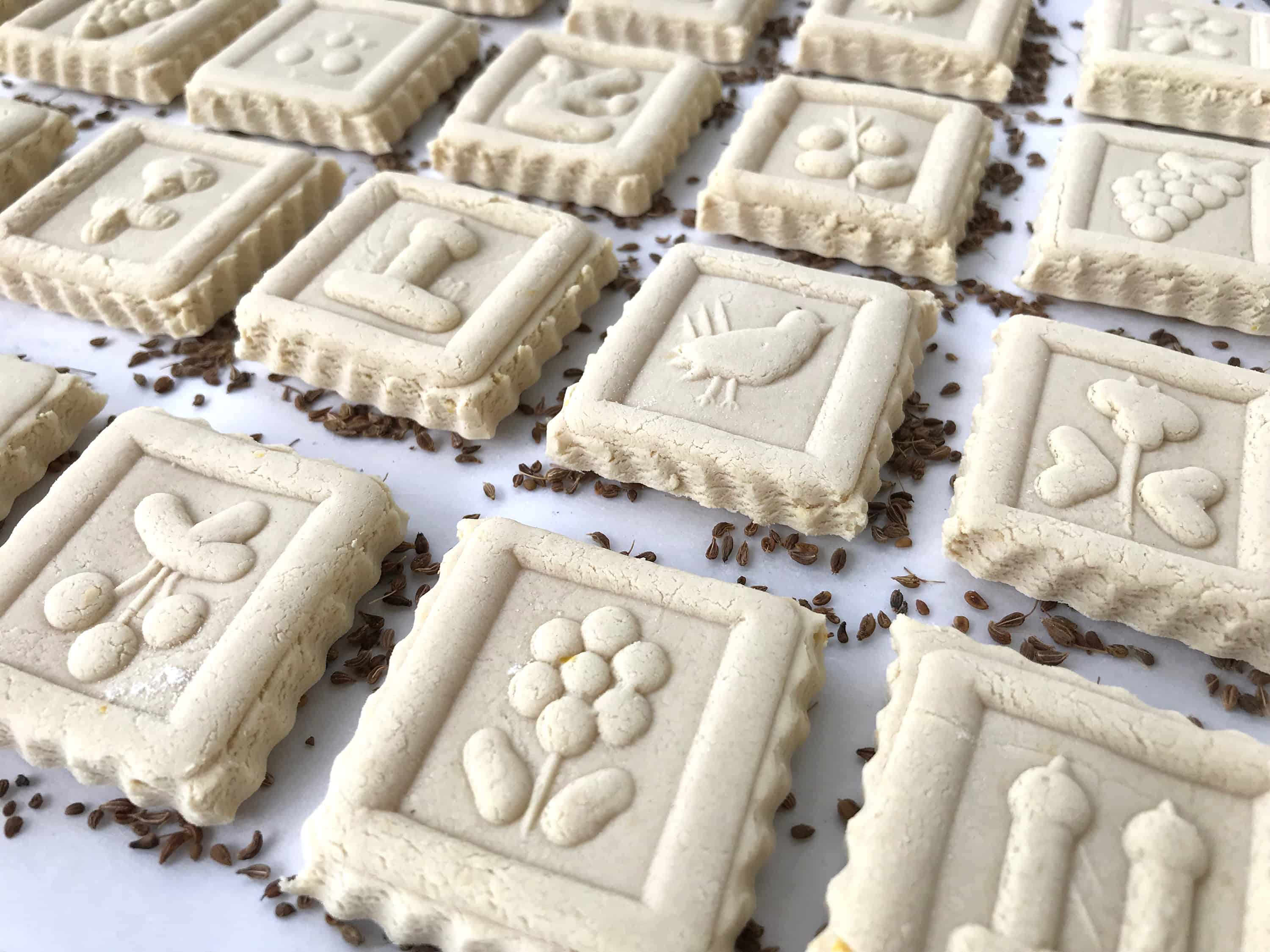
Key #5: Moisten the Bottom of Each Air-Dried Springerle Before Baking Them
The purpose of this step hearkens back to the meaning of their name, Springerle, which means “little jumpers.” Springerle rise in a particular way, creating their characteristic platform on the bottom or “feet” as they call it in Germany. In other words, they “spring up” on their “feet” while baking.
There is an important functional purpose for lightly moistening the bottom of the cookies. Once the cookies have dried for 24 hours they can have uneven moisture spots throughout. This can result in the Springerle rising more quickly on one side than the other, resulting in slanted or lop-sided cookies. To prevent that we lightly and evenly moisten the bottoms by gently pressing the cookie down on a damp cloth. That’s the key for enabling an even-leveled rise.
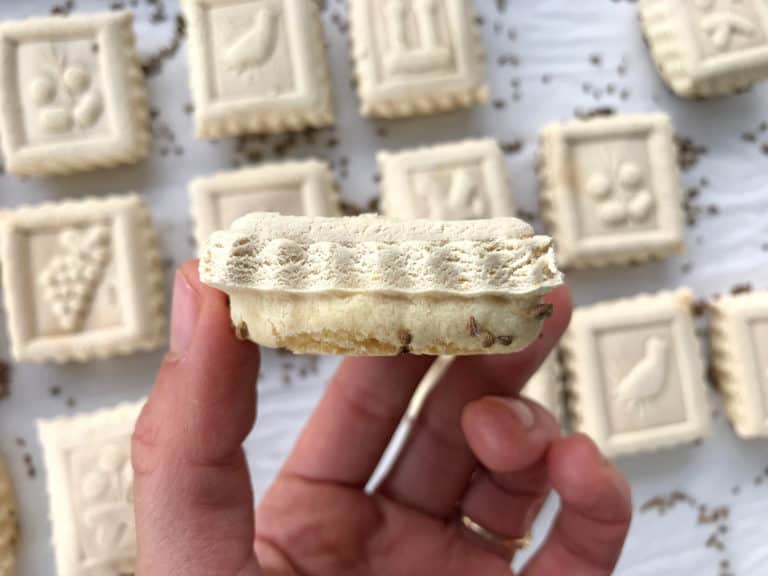
Authentic Springerle Cookies Recipe
Let’s get started!
Place the eggs in a stand mixer with the whisk attachment in place. Beat the eggs until foamy. Add the powdered sugar, a little at a time along with the vanilla sugar (or extract), anise oil and lemon zest (if using).
Once all the powdered sugar has been added continue to beat the mixture for 10 minutes. Yes, that’s 10 full minutes. The batter needs to be very loose and airy. Note: Follow the instructions on your stand mixer to give your machine a rest after the suggested amount of time so as not to overwork your mixer.
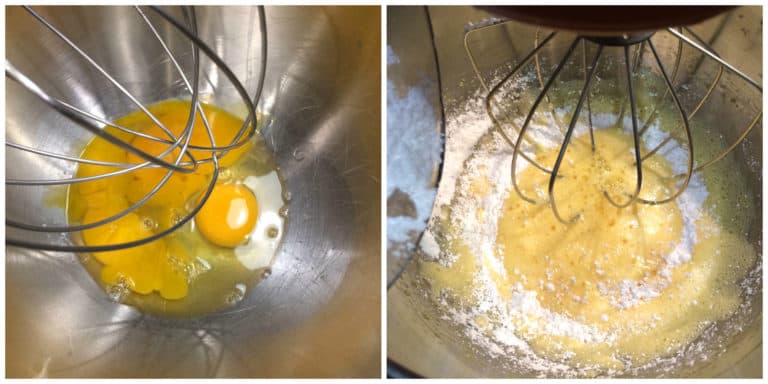
Combine the flour, baker’s ammonia and salt in a bowl. Add HALF of the flour mixture to the wet mixture along with the and beat it for a full 15 minutes.
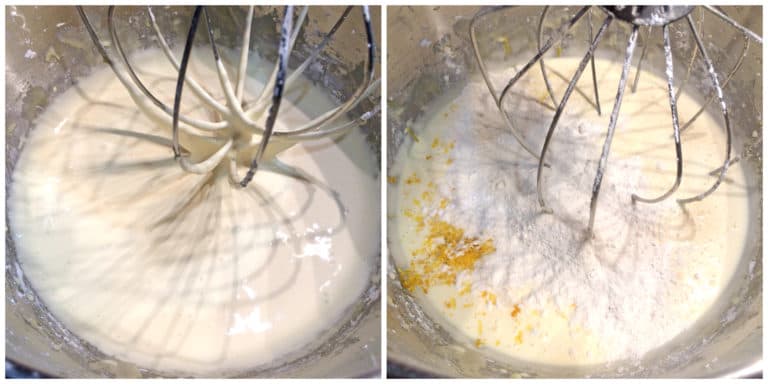
Attach the paddle attachment now. Add the remaining flour and beat for another 5 minutes.
The dough should be very soft but not wet and sticky.
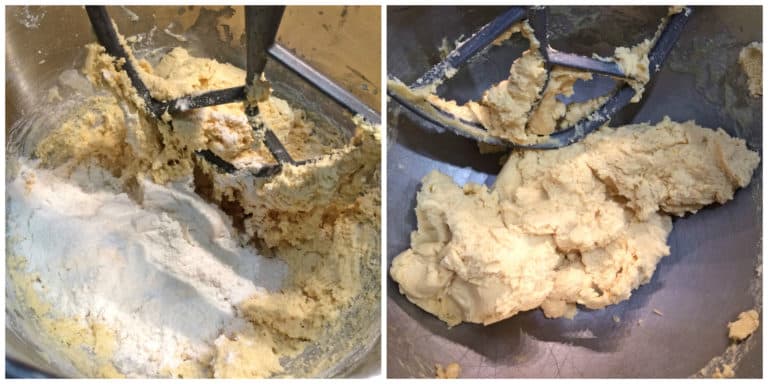
Form the dough into a ball, flatten it to an inch-thick disk, wrap it in plastic wrap and refrigerate for at least an hour or overnight.
The next day roll out the cold dough to about 1/3 inch thick (1 cm) on a floured work surface.
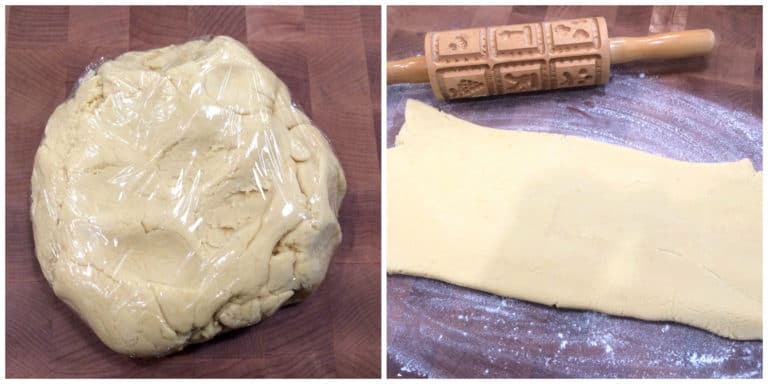
Use your molds or rolling pin to make the shapes and cut them out with sharp knife or pastry cutter. If you’re using molds lightly dust them with flour to prevent the dough from sticking.
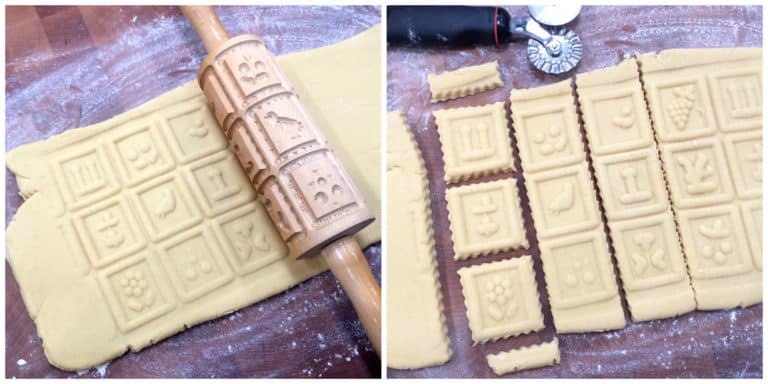
Toast the whole anise seeds in a dry pan over medium-high heat until aromatic, being careful not to let them scorch. Place the anise seeds on a lined cookie sheet, spreading them out evenly.

Lay the Springerle on top of the anise seeds on the baking sheet. Let them dry at room temperature for a full 24 hours, longer if you’re in a place with high humidity. The outside of the Springerle should be dry.
Lay a damp towel on the counter and gently press the Springerle down onto it to very lightly and evenly moisten the bottoms. Return the Springerle back to the cookie sheet.
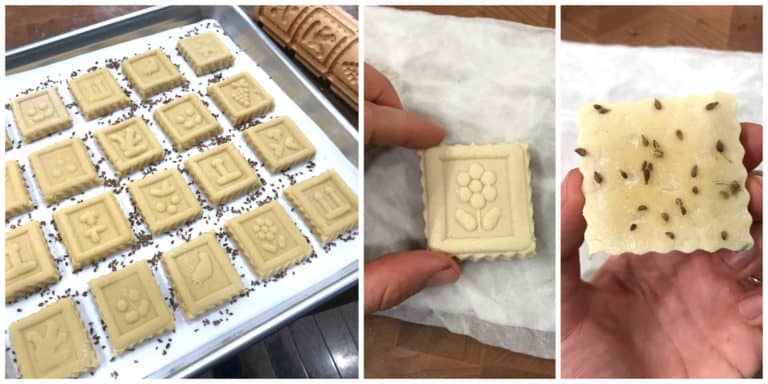
In an oven preheated to 300 degrees F with the rack positioned in the middle, bake the cookies for 20-30 minutes. Do not let the cookies turn golden, they’re supposed to stay very pale, basically the same color as when you put them in the oven.
The Springerle should have risen evenly to create their characteristic “feet” or platform underneath. Let the cookies cool off completely. They will become very hard as they cool.
Springerle are traditionally stored in airtight containers with half of an apple next to them inside the container to create a little bit of moisture to gradually soften the cookies over time. Periodically change out the apple. Once the Springerle have slightly softened up you can remove the apple and then continue storing them in the airtight container waiting for the flavor to develop.
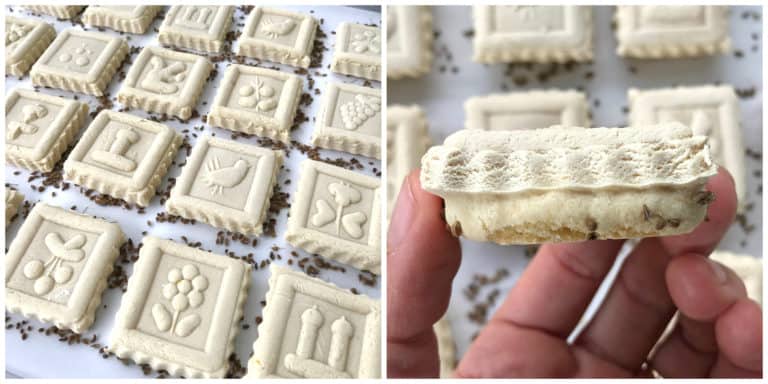
One of the nice things about Springerle is that they’re supposed to be made far in advance. So you can make them weeks before Christmas, set them aside and forget about them, and continue on with your other Christmas preparations.
Most Springerle bakers agree that waiting 3-4 weeks before eating them is best to allow the flavor and texture to develop.Enjoy these Springerle on their own or, as is tradition, enjoy them with a hot beverage and dip them.
Enjoy!
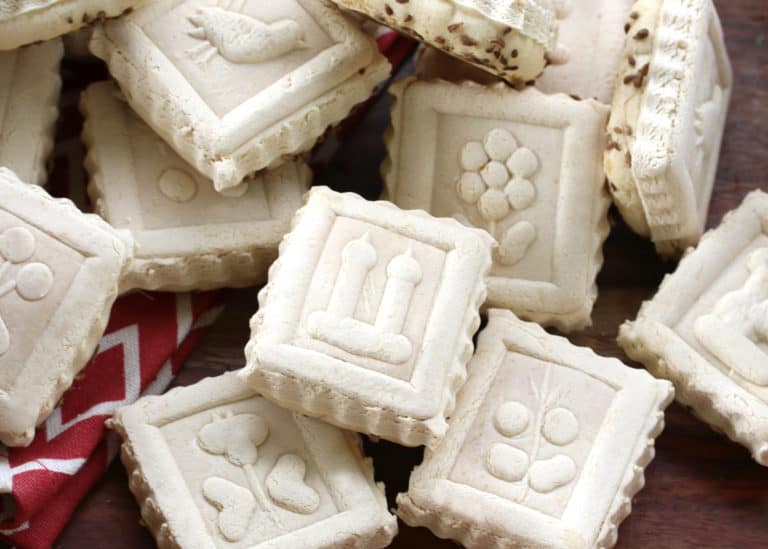
To put your molds and mold rolling pins to further use, be sure to try my traditional Speculoos cookies!
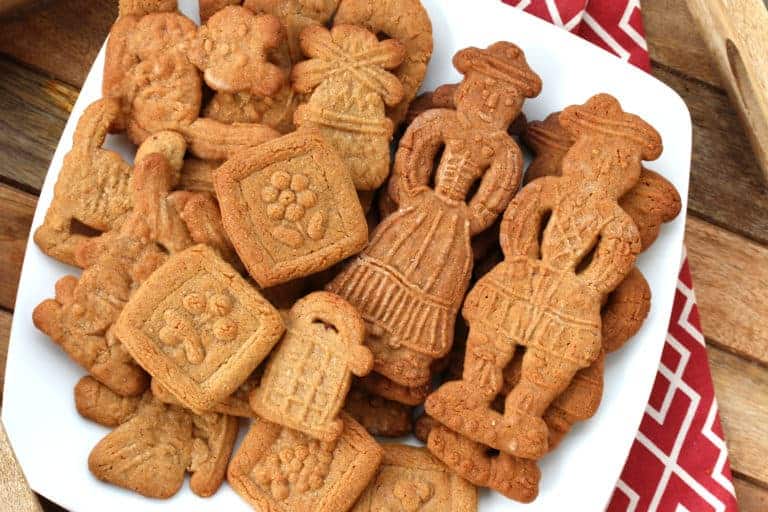
For more traditional German Christmas recipes try my:
- Stollen
- Zimtsterne
- Pfeffernüsse
- Lebkuchen
- Marzipan
- Bethmännchen
- Heidesand
- Magenbrot
- Kokosmakronen
- Marzipankartoffeln
- Haselnussmakronen
- Kinderpunsch
- Vanillekipferl
- Linserkekse
Save This Recipe
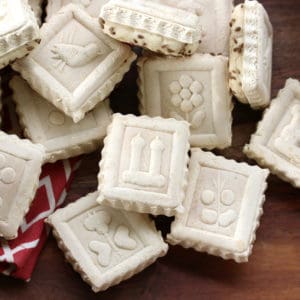
Authentic German Springerle Cookies
Equipment
Ingredients
- 3 large eggs , room temperature (the eggs must be large; if you are using medium add an additional egg)
- 3 cups powdered sugar (confectioner's sugar) (if using cups start with slightly less flour, 2-3 tablespoons, and add the rest as needed)
- 1 teaspoon quality pure vanilla extract (or 2 packets of vanilla sugar)
- 1/4 to 1/2 teaspoon quality 100% pure anise oil (not extract), how much you use depends on how strong of an anise flavor you want.
- 3 cups all-purpose flour (if measuring in cups start with slightly less flour and add the rest as needed if the dough is too soft/sticky)
- 1/4 teaspoon baker's ammonia *slightly less than 1/4 teaspoon (see blog post for explanation about baker's ammonia)
- 1/4 teaspoon salt
- zest of one lemon
- 2 tablespoons whole anise seeds
Instructions
- Place the eggs in a stand mixer with the whisk attachment in place. Beat the eggs until foamy. Add the powdered sugar, a little at a time along with the vanilla extract and anise oil.Once all the powdered sugar has been added continue to beat the mixture for 10 minutes. Yes, that's 10 full minutes, do not reduce the time. The batter needs to be very loose and airy. Note: Follow the instructions on your stand mixer to give your machine a rest after the suggested amount of time so as not to overwork your mixer.
- Combine the flour, baker's ammonia and salt in a bowl. Add HALF of the flour mixture to the wet mixture along with the lemon zest and beat it for a full 15 minutes, do not reduce the time (if the mixture is too dry for your whisk attachment, use the paddle attachment).Attach the paddle attachment, add the remaining flour and beat for another 5 minutes.The dough should be very soft but not wet and sticky. If the dough is too dry or stiff mix in a little more lightly beaten egg.Form the dough into a ball, flatten it to an inch-thick disk, wrap it in plastic wrap and refrigerate for at least an hour or overnight.
- The next day roll out the cold dough to about 1/3 inch thick (1 cm) on a floured work surface (if the dough chilled for several hours and is very firm, let it sit at room temperature until soft enough to work with). Use your molds or rolling pin to make the shapes and cut them out with sharp knife or pastry cutter. If you're using molds lightly dust them with flour to prevent the dough from sticking.Toast the whole anise seeds in a dry pan over medium-high heat until aromatic, being careful not to let them scorch. Place the anise seeds on a lined cookie sheet, spreading them out evenly.Lay the Springerle on top of the anise seeds on the baking sheet. Let them dry at room temperature for a full 24 hours, longer if you're in a place with high humidity. The outside of the Springerle should be dry.
- After the cookies have dried for at least 24 hours, lay a damp towel on the counter and gently press the Springerle down onto it to very lightly and evenly moisten the bottoms. Return the Springerle back to the cookie sheet.In an oven preheated to 300 degrees F with the rack positioned in the middle, bake the cookies for 20-30 minutes. Do not let the cookies turn golden, they're supposed to stay very pale, basically the same color as when you put them in the oven.
- The Springerle should have risen evenly to create their characteristic "feet" or platform underneath. Let the cookies cool off completely. They will become very hard as they cool. Springerle are traditionally stored in airtight containers with half of an apple next to them inside the container to create a little bit of moisture to gradually soften the cookies over time. Periodically change out the apple. Once the Springerle have slightly softened you can remove the apple and then continue storing them in the airtight container waiting for the flavor to develop.
Most Springerle bakers agree that waiting 3-4 weeks before eating them is best to allow the texture and flavor to develop.Enjoy these Springerle on their own or, as is tradition, enjoy them with a hot beverage and dip them.Makes about 34 Springerle depending on their size.
Notes
Originally published on The Daring Gourmet November 17, 2019



















Hello! First of all, I love your recipes…especially your Christmas Stollen. I tried to make these cookies as directed and stored them with the apple.. Unfortunately I found that the cookies had molded. Have you ever had this issue? Did I perhaps not back the cookies long enough? Thank you
Thank you so much, Laura! :) That’s a real bummer about the Springerle. No, I have never had that issue and that would only happen if there was an excessive amount of moisture, more than just a piece of apple would create. Were the cookies fully cooled when you placed them in the container? Are you in a very humid area? Was the apple gargantuan? :)
They were fully cooled and humidity typically isn’t a problem in the heart of Texas. Perhaps I moistened the bottoms too much when I put them in the container? I will definitely try again. Thanks
I have bought the molds and am really looking forward to trying this recipe! I wanted to ask you a question, though. I have an old Mixmaster mixer that does not have a whisk attachment. Is it possible to use it to make these cookies? Thank you so much!
Hi Carol, whisk is definitely better for ensuring enough air gets in the mixture but in the absence of one the regular mixing blades should be okay. Happy baking!
I would love to make these because my husband was a Lutheran pastor and the elderly German women in the church made these for us every Christmas. He is now gluten free. Would any all purpose gluten free flour work or a gf pastry blend? Thank you for this glorious looking cookie.
Hi Sue, I’m not sure how well this would adapt to GF. Perhaps some of our readers have tried and can chime in.
I have prepared these cookies for over 50 years, but I’m afraid, I can no longer find hartshorn crystals (Ammonica carbonate/bakers ammonia), as I’ve moved overseas. Google suggests I can substitute Baking powder. Have you tried this substitution and if so, (as google suggested) a 1:1 ratio? Thank you for your help!
Hi Theresa, yes that’s correct. It won’t produce the same texture but that is the most commonly recommended substitute for baker’s ammonia.
Anise is not a flavor cared for in my family and I was wondering if lemon oil could be used instead and instead of anise seed if lemon zest or chopped fresh rosemary could be used. Has anyone made these without the anise flavor?
Hi RML, without anise or any other flavoring these will basically taste like nothing – just flour and sugar. Anise is the characteristic flavor of Springerle but if you don’t like the flavor then yes, I would definitely substitute it with something else. Springerle are thoroughly neutral in flavor so really you can use anything you like for the added flavor.
Hello. This recipe looks great. I have kids with celiac and we miss out on so many recipes and traditions. Is there any recipe you have tried that is gluten free that can work for this? Thank you for your time.
I, too, am hoping for guidance on making these GF. My dear Mom made these for many years (fond childhood Christmas memories) but now has Celiac…. It would mean SO much to be able to make these so she could relive those memories, as well.
Anyone??
Just wanted to come by and say that you made what seems like a daunting recipe, feel so approachable. I really appreciate you breaking down the ingredients and their reason for being incorporated and also the very particular ways and why you need to mix everything. This is now my go to recipe when I want to make these, and I made it for the first time ever a couple days ago. I’m so excited! I made some mistakes along the way, but the trial and error really reinforced your instructions and why you asked for things to be made a specific way. Dusting the molds with flour was probably the most challenging bit for me since I’ve never used molds before and I came across them getting dusted with too much flour at one time. I’ve worked out tying up some powdered sugar in some cheesecloth and use that to dust the mold instead. Took me a couple tries to figure out, but that seems to be working so far!
Thanks so much for the feedback, Connie! I’m happy that you’ve persisted and that these have been a success!
I love this recipe! I use the weight measurements and always double, watching my humidity and egg size – if really dry I have to add another egg (when doubling). This recipe gives me consistently well formed cookies and a nice foot. I leave them out for 4 days to “mellow”. Can’t thank you enough for this recipe! Any flavors seem to work well – my fave is anise and valencia orange.
Thank you so much, Jane, I’m thrilled they’ve been a success and appreciate the feedback! And nice touch with the Valencia orange!
It is Valencia Orange Oil, just to clarify.
If you want to save a lot of time, use a blender to mix the eggs, powdered sugar, and other wet ingredients. My mother converted the family recipe in the mid-20th century to use a Sunbeam mixer to whip up the eggs, but she insisted that the powdered sugar had to be stirred in by hand, two tablespoons at a time, using a slotted spoon (yes, it MUST be slotted). After overworking my shoulder a few times doing that, I noticed that the end result is a slurry of eggs and powdered sugar, not a fluffy merengue like the eggs start out. I figured there must be some kitchen appliance that could do that, so I tried my blender. I whipped up the eggs in less than a minute and then added about 1/4 of the powdered sugar, blended, and repeated until all the sugar had been combined with the eggs. I added extract at the end with a quick pulse blend. So, in just a few minutes, I had the same results that took ten times as long using a mixer. My new method got the Mom seal of approval when she tried my cookies.
If you’re interested, I have a more detailed description of this method from my recipe notes that gives blending times and speeds. Thanks for your detailed information about Springerles!
I don’t have a stand mixer so using a blender is perfect for me. Please send me the detailed description of your blending method. Thanks and Merry Christmas!
Please send me your springerle recipe
Thanks
Chris
could I get your blender times? I don’t have a fancy mixer either…. Have you made them without anise?
I have my mothers rolling pin, which looks similar to yours. I tried your recipe this year, as my moms is just flour, eggs, and powdered sugar. She did not mix the ingredients as long as you. My question is how do you get such a perfect pattern? If I push hard on the rolling pin, the dough flattens and become too thin. Otherwise, my pattern barely shows. I did add extra flour, as my eggs were probably extra large, so the dough was very wet and sticky. I live in Hawaii, so have a hard time drying out the dough. They are drying now and I will bake tomorrow, but I’m disappointed the pattern will be weak.
Ohh I love those cookies – I had similar childhood experience, remember the cookies spread out over night to dry-out, a few days before Christmas. When baked they were soft but later, became hard as a rock and we would dip them in Milk to soffen a bit – I wanted my daughter to make some for me but she never took interest because they take to much time. I shared the cookie with my children when they were young and they didn’t like them so maybe that’s why.
btw I live in Waipio Gentry near Outback stake.
Maybe try again with just large eggs. If adding more flour – add equal parts flour and powdered sugar. If your dough is wet and sticky – you may have issues with the drying. Dough should be almost a play dough consistency.
I wanted to reply to your question. The rolling pin will make all of the difference in the world. The author has a rolling pin in which the entire desigh is raised with deep indentations all around. That’s why the pattern comes out so perfect. It’s a high-end rolling pin. The rolling pin I have is much less expensive. The design is not raised and there’s no deep indentation/groove all around it. Mine just have very, very shallow lines for grooves. Hence the design won’t be as deep and/or stand out. If the dough is very wet and sticky, it will make it even worse. I weigh all my ingredients and my dough was way too wet and sticky. I had to add 3 more tablespoons each of flour and powdeed sugar in order to obtain a “play dough” consistency! I hope this helps you! I’m looking for a rolling pin like the author. I haven’t found it yet. I’ll bet they carry them in German import stores if there are any in your area! Have a great day!
Can’t wait to make using my grandmothers rolling pins. This was a favorite childhood cookies. – one question- is the salt table salt or Kosher salt? Thank you!
Hi Katie, either will work fine. Happy baking!
Kosher salt and table salt have different densities, though, so the measurements will differ. Which one is the measurement for? I would hate to have the cookies turn out too salty or not salty enough. Thank you.
Hi Jennifer, I generally use and recommend kosher or sea salt but whichever you use, including table salt, the quantities are minimal enough that they won’t remotely result in cookies that are too salty.
Thank you for your detailed directions. I followed them to a T and am very happy with the results. I am lucky to have a kitchenaid K5A which functions as a workhorse but think it would be difficult with a hand mixer. Can’’t imagine how our great grandmas made these with a wooden spoon! All the best to you!
Thank you so much, Jolly, I’m thrilled they were a success! I couldn’t agree more, I’m very thankful for modern technology! :) A question for you, Jolly, did you use the U.S. cup measurements or metric? I’m trying to get to the bottom of why a few of our readers have struggled with this recipe.
My German grandmother used to send these to us every Christmas. She got the family together, and they took turns with the wooden spoon.
I just made this recipe exactly as written using the weight measurements. I found the final dough to be a bit wet/sticky so I added a bit (Tbsp) of flour at a time until the dough was no longer sticky to the touch. I waited just over an hour of refrigeration to roll them out and let them sit 24 hours. I just took them out of the oven (25 minutes) and they look great! My question is does it matter if the cookies are stacked on top of one another while stored? Or should they be separated by parchment paper? Also, how many days should I put them with a sliced apple or bread before just storing them for the flavor to develop? Will they feel softer to the touch? I’m looking forward to trying them out at Christmas!
Wonderful, Cathy, I’m so glad they were a success, thank you for the feedback! They can stored stacked on each other without anything in between them, that’s no problem at all. You can keep them stored with the apple or bread slice until you determine the cookies are “soft” enough (understanding that Springerle are never going to become “soft”, it will just take the slight edge of their hardness :)
I don’t think the metric equivalencies are correct in the recipe? For instance, 6 cups isn’t 350 grams, but 750 grams? Both for the sugar and the flour? I made these using 750 grams, which worked.
I see that it’s a problem with the multiplier on the recipe–I was opting for 2x recipe, and while it doubled the measurements of the cup, it doesn’t change the grams!
thank you. I want to try but I never ever bake with US cups because it is not accurate. 6 cups definitely is not 350 grams. i would have used 350 if you didn’t mention that because I would think nobody will make such mistake if they are gonna put the grams measurement in a recipe and I don’t like manually measure everything and convert back to grams and having to wash extra tools.
I followed the steps to the letter and the cookies turned out magnificently. I love how they rise, as if on little inflatable mattresses. will definitely bake some more of these.
Fantastic, Rosemarie, I’m so happy they were a success and that you enjoyed them! Thanks so much for the feedback!